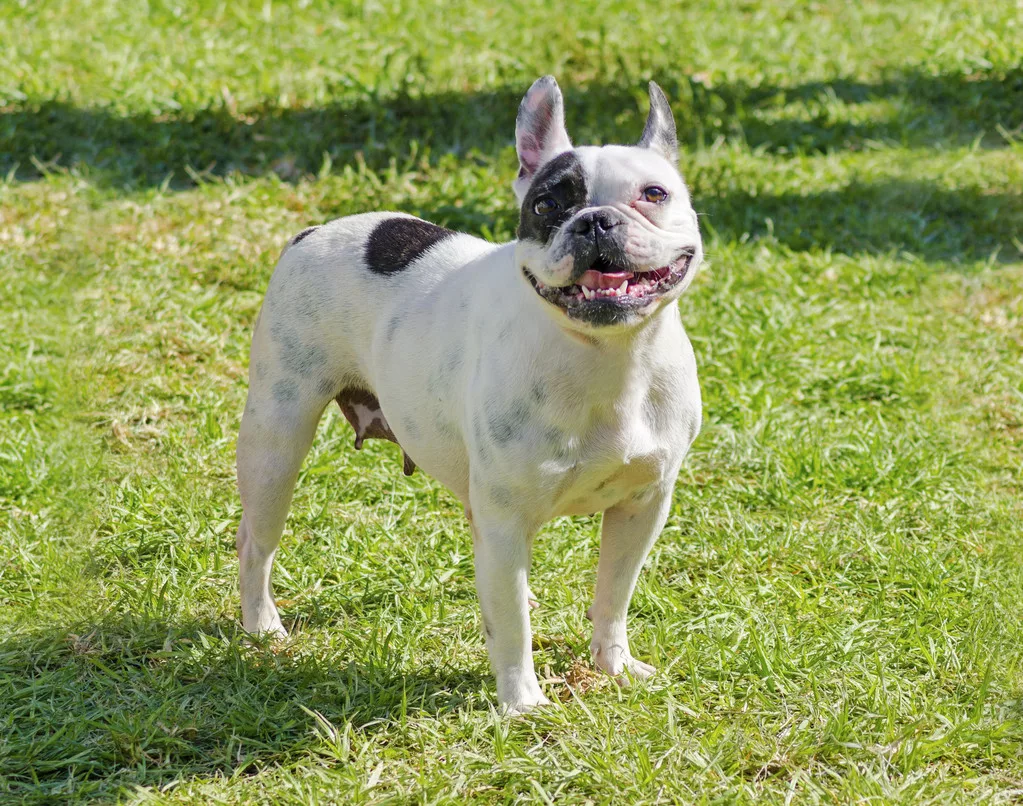Boston Terriers are not considered one of the dog breeds that are most prone to hearing loss or deafness. However, like many other breeds, some individual Boston Terriers can experience hearing issues. The prevalence of hearing loss or deafness in Boston Terriers may be influenced by various factors, including genetics, environmental factors, and individual health. If you are interested in reading more on Boston Terrier health issues, click here.
Key Points Regarding Boston Terriers and Deafness:
Genetic Factors: Some Boston Terriers may inherit a genetic predisposition to hearing issues. Responsible breeders aim to reduce the risk of hereditary deafness by selectively breeding dogs without known hearing problems and conducting health tests on breeding stock.
Congenital Deafness: Some Boston Terriers may be born deaf (congenital deafness) due to genetic mutations or developmental problems during fetal development. This type of deafness is typically present from birth.
Acquired Deafness: Acquired deafness in Boston Terriers can result from factors such as ear infections, exposure to loud noises, head trauma, or age-related degeneration. Acquired deafness can occur at any stage of a dog’s life.
Regular Veterinary Care: It’s important for Boston Terrier owners to provide regular veterinary care and monitor their dogs’ hearing throughout their lives. Veterinarians can perform hearing tests to assess the dog’s auditory health.
Prevention and Care: Owners should take measures to prevent ear infections by keeping their Boston Terrier’s ears clean and dry. They should also protect their dogs from exposure to excessively loud or harmful noises.
Deaf Boston Terriers: If a Boston Terrier is diagnosed with deafness, it’s essential to adapt their training and communication methods, relying on visual cues and hand signals. Deaf dogs can lead happy and fulfilling lives with the right care and understanding from their owners.
In summary, while Boston Terriers are not one of the breeds most prone to hearing loss or deafness, there is still a possibility that some individuals may experience hearing issues. Responsible breeding practices and proper care can help reduce the risk of hereditary deafness, and regular veterinary check-ups can monitor any changes in hearing ability throughout their lives.

Boston Terriers, like many other dog breeds, have distinctive ears and hearing abilities. Here’s an overview of their ears and hearing characteristics:
Boston Terrier’s Ears and Hearing:
Ears:
Ear Shape: Boston Terriers have small, fine-textured ears that are typically carried erect. The ears are set high on the head and are often referred to as “bat ears” due to their resemblance to a bat’s ear shape.
Ears and Temperature Regulation: The Boston Terrier’s thin ears can help regulate their body temperature. Since they are a brachycephalic breed (short-nosed), they are susceptible to overheating, and the ears play a role in helping them stay cool.
Ear Health: It’s essential to keep Boston Terriers’ ears clean and dry to prevent ear infections. Regular inspection and cleaning, as well as ensuring their ears are well-ventilated, can help maintain ear health.
Hearing Ability:
Acute Hearing: Boston Terriers typically have a good sense of hearing. Their keen sense of hearing is essential for communication, awareness of their environment, and responding to auditory cues from their owners.
Sensitivity to High-Pitched Sounds: Like many dogs, Boston Terriers are sensitive to high-pitched sounds, such as sirens, alarms, or other loud noises. These sounds can startle or discomfort them.
Directional Hearing: Dogs, including Boston Terriers, have the ability to locate the source of a sound due to their ability to pinpoint the direction of the sound. This skill is particularly valuable for detecting potential threats or sources of interest.
Communication: Boston Terriers use their hearing to communicate with their owners and other dogs. They can hear and respond to verbal commands, praise, or warnings.
Hearing Changes with Age: As with many dogs, a Boston Terrier’s hearing may change with age. Some may experience age-related hearing loss, which can affect their responsiveness to commands or sounds. Regular veterinary check-ups can help monitor any changes in hearing ability.
Genetic Factors: While Boston Terriers, in general, have good hearing, it’s important to consider that hereditary factors can affect hearing in individual dogs. Some Boston Terriers may be more prone to congenital hearing issues due to genetic predispositions.
In summary, Boston Terriers have unique “bat ears” that are not only a distinctive feature of the breed but also play a role in temperature regulation. Their hearing abilities are generally sharp, allowing them to communicate effectively and be aware of their surroundings. However, like all dogs, their hearing can be affected by age and genetic factors, so regular ear care and monitoring of hearing changes are essential to ensure their well-being.

1. Why is my Boston Terrier Deaf?
Deafness in Boston Terriers can occur for various reasons, both congenital and acquired. Some Boston Terriers are born deaf due to genetic factors, while others may become deaf later in life due to age-related changes, injury, or medical conditions.
Deafness in Boston Terriers is a complex issue that can arise from a multitude of factors. One of the primary causes of deafness in this breed is congenital, meaning that some Boston Terriers are born deaf due to genetic factors. Hereditary deafness can be traced back to their lineage, and it often occurs when the puppy inherits two copies of a specific gene associated with deafness. While this genetic predisposition may not be apparent in the puppy’s early stages, it becomes evident as they grow, and their hearing doesn’t develop as expected. Responsible breeders take measures to avoid breeding dogs with a history of hereditary deafness to reduce the risk.
On the other hand, acquired deafness can affect Boston Terriers later in life. Aging can lead to age-related hearing loss, just as it does in humans. As dogs grow older, the sensitive structures within their ears can naturally degrade, resulting in reduced hearing capabilities. Additionally, traumatic injuries, such as head trauma, can damage the delicate auditory mechanisms within the ear and cause deafness. Moreover, certain medical conditions, including chronic ear infections or ototoxic medications, can also contribute to acquired deafness in Boston Terriers.
Dealing with a deaf Boston Terrier requires understanding, patience, and adjustments in communication. Fortunately, these intelligent and adaptable dogs can lead fulfilling lives, even with hearing impairment. Training them with hand signals and positive reinforcement can help bridge the communication gap and strengthen the bond between the dog and their owner. Regular veterinary check-ups and proactive care are essential to address any potential hearing issues and ensure the well-being of Boston Terriers throughout their lives.

2. What Causes Deafness in Boston Terriers?
Deafness in Boston Terriers can be caused by several factors:
Genetic factors: Some Boston Terriers may inherit a genetic predisposition to deafness from their parents.
Deafness in Boston Terriers is a multifaceted issue with several underlying causes, one of which is genetic factors. Some Boston Terriers are unfortunate in inheriting a genetic predisposition to deafness from their parents. This congenital deafness can be traced back through the dog’s lineage, and it often occurs when the puppy inherits two copies of a specific gene linked to deafness. Responsible breeding practices aim to reduce the likelihood of hereditary deafness by avoiding the pairing of dogs with such genetic histories. Ethical breeders carefully select breeding pairs to minimize the risk of passing on these genes, prioritizing the overall health and well-being of the puppies.
Congenital factors: Some Boston Terriers are born with hearing impairments due to issues during development in the womb.
In some cases, congenital deafness may not be apparent immediately as Boston Terrier puppies are born with their hearing apparatus seemingly intact. However, as they grow, it becomes evident that their hearing isn’t developing as expected, and this can be attributed to their genetic predisposition to deafness. This genetic factor contributes to a significant portion of Boston Terriers being born deaf or experiencing hearing loss at a young age.
While genetic factors are a primary cause of deafness in Boston Terriers, it’s important to note that other factors, including age-related changes, injuries, and medical conditions, can also lead to deafness in this breed. Understanding the various causes of deafness is crucial for Boston Terrier owners and breeders, as it can help in early identification and appropriate management of hearing issues in these delightful companions.
Acquired factors: Trauma, ear infections, exposure to loud noises, or age-related degeneration can cause acquired deafness in Boston Terriers.
Deafness in Boston Terriers can also occur due to acquired factors, which encompass a range of non-genetic causes. Understanding these acquired factors is essential for Boston Terrier owners to recognize and address potential hearing issues in their beloved pets.
- Trauma: Traumatic injuries to the head or ears can lead to deafness in Boston Terriers. This can result from accidents, falls, or any form of head trauma that damages the delicate auditory structures within the ear. In such cases, the extent of the injury and the specific areas affected can determine the degree of hearing loss.
- Ear Infections: Chronic or recurrent ear infections can contribute to acquired deafness. Boston Terriers, like many other breeds, are susceptible to ear infections due to their floppy ears, which can trap moisture and debris. These infections can damage the sensitive components of the ear, leading to hearing impairment over time. Regular ear care and prompt treatment of infections are crucial in preventing this form of acquired deafness.
- Exposure to Loud Noises: Prolonged or repeated exposure to loud noises, such as fireworks, gunshots, or heavy machinery, can damage the hair cells in the inner ear responsible for hearing. While dogs may not always be exposed to such noises, in environments where these sounds are prevalent, it’s important to take measures to protect their hearing.
- Age-Related Degeneration: Just as in humans, aging can lead to age-related hearing loss in Boston Terriers. Over time, the sensitive auditory structures within the ear may naturally degrade, resulting in reduced hearing capabilities. This form of acquired deafness is often progressive and can affect an older dog’s quality of life.
Recognizing the specific cause of acquired deafness is crucial in determining the appropriate course of action. For instance, traumatic injuries may require immediate medical attention, while chronic ear infections can be managed with the guidance of a veterinarian. Preventative measures, such as protecting a Boston Terrier from loud noises, can help avoid noise-induced hearing loss. Regular veterinary check-ups can also aid in early detection of age-related hearing changes, allowing for timely adjustments in care and communication to support the dog’s overall well-being.
In summary, acquired factors can lead to deafness in Boston Terriers, and being aware of these potential causes is essential for ensuring the health and happiness of these cherished canine companions.

3. Is there a Correlation Between Boston Terrier Markings and Deafness?
There isn’t a direct correlation between Boston Terrier markings and deafness. Deafness in Boston Terriers is primarily related to genetic and developmental factors rather than coat color or markings. While there’s a common misconception that white coat patterns in dogs are associated with deafness, it’s not exclusive to Boston Terriers, and the relationship is more complex and varies among breeds.
The notion that coat color or markings are linked to deafness in dogs is a misunderstanding that has persisted for some time. This misconception often centers around dogs with predominantly white coats, and it has led to the belief that the presence of white fur, particularly around the head or ears, is a direct indicator of potential deafness. However, the reality is more nuanced, and it’s essential to clarify the actual factors contributing to deafness in dogs.
Deafness in Boston Terriers, like in other breeds, is primarily rooted in genetic and developmental factors. While it’s true that some dogs with predominantly white coats may be more prone to congenital deafness, it’s not a guaranteed outcome, and many white-coated dogs have normal hearing. The genetics of deafness are complex, involving multiple genes, and can vary widely between breeds.
In Boston Terriers, hereditary deafness can occur due to specific genetic mutations or a genetic predisposition within certain bloodlines. Responsible breeders aim to minimize the risk of hereditary deafness by conducting health tests and breeding dogs with no known hearing problems. Thus, it’s crucial to emphasize that a Boston Terrier’s coat markings, whether they have a predominantly white coat or not, do not directly correlate with the likelihood of deafness. Rather, potential deafness is influenced by genetic factors and is not determined solely by their appearance.

4. Should a Deaf Dog be Bred?
Responsible breeding practices discourage breeding dogs with known genetic or hereditary health issues, including deafness. It’s generally recommended not to breed dogs that are deaf or have a history of deafness in their lineage to reduce the risk of passing on this condition to future generations.

5. Why Has my Dog Suddenly Gone Deaf?
Sudden deafness in dogs can result from a variety of causes, such as ear infections, trauma, foreign objects in the ear, or neurological issues. If your Boston Terrier has suddenly lost its hearing, it’s essential to consult a veterinarian to identify the underlying cause and explore potential treatment options.
Sudden deafness in dogs can be a distressing experience for both the pet and their owner. When a dog experiences an abrupt loss of hearing, it’s crucial to investigate the potential causes and seek prompt veterinary attention for a thorough evaluation. Here are some of the common reasons why a dog may suddenly go deaf:
Ear Infections: One of the most frequent causes of sudden deafness is an ear infection. Infections can lead to inflammation and a buildup of fluid or pus in the ear canal, which can block sound waves from reaching the eardrum. In some cases, the infection may be painful and require immediate treatment to alleviate discomfort and prevent hearing loss.
Trauma or Injury: Physical trauma to the head, ears, or skull can damage the delicate structures of the ear, leading to sudden deafness. This trauma could result from accidents, falls, or incidents such as being struck by a heavy object.
Foreign Objects: Dogs are naturally curious and may insert foreign objects into their ears, which can obstruct the ear canal or cause damage to the eardrum. This can lead to a sudden loss of hearing and may necessitate intervention to remove the object safely.
Neurological Issues: Certain neurological conditions or disorders can affect a dog’s hearing, leading to sudden deafness. Tumors, nerve damage, or other neurological diseases can impact the auditory pathways and result in hearing impairment.
Age-Related Changes: While not sudden in the traditional sense, some older dogs may experience age-related hearing loss. This can manifest gradually but become more noticeable over time as the dog’s ability to hear high-pitched sounds diminishes.
If your Boston Terrier has suddenly lost its hearing, it’s imperative to consult a veterinarian without delay. The veterinarian will conduct a thorough examination, which may include otoscopic evaluation of the ear canals, imaging studies, and hearing tests. Once the underlying cause is identified, appropriate treatment options can be discussed. In some cases, early intervention can help restore or preserve hearing, while in others, the goal may be to manage any pain or discomfort associated with the condition and improve the dog’s overall quality of life.

6. How do I Know if my Boston Terrier Puppy is Deaf?
You can perform a simple hearing test at home. Make a loud noise or clap your hands to see if the puppy reacts. If the puppy doesn’t respond to loud sounds or seems unresponsive to noises that usually catch their attention, it may be a sign of deafness. However, a definitive diagnosis should be made by a veterinarian through specialized testing, such as the BAER (Brainstem Auditory Evoked Response) test.
Identifying potential hearing issues in your Boston Terrier puppy is important for their well-being and development. While a definitive diagnosis of deafness should be made by a veterinarian through specialized testing, there are steps you can take to assess your puppy’s hearing at home:
Observe Responsiveness: One of the simplest ways to gauge your Boston Terrier puppy’s hearing is through their responsiveness to everyday sounds. Pay attention to how your puppy reacts to common auditory cues, such as clapping your hands, whistling, or calling their name. A puppy with normal hearing will typically react to these sounds by turning their head, pricking their ears, or showing signs of curiosity or alertness.
Noise Test: You can conduct a noise test by making sudden, loud noises in the vicinity of your puppy, taking care not to startle them. This can include dropping a book or jingling keys. A hearing puppy will usually react with a startle or an orienting response towards the source of the noise.
Sound Play: Engage in sound-based play with your puppy. For example, you can introduce a squeaky toy or engage in games that involve making noise. A hearing puppy will likely show interest and playfully respond to these auditory stimuli.
Response to Name: Call your puppy by name from different locations within the room or house. A hearing puppy should react by looking towards you or moving in the direction of your voice.
While these at-home tests can offer initial insights into your Boston Terrier puppy’s hearing ability, they are not definitive diagnostic tools. A confirmed diagnosis of deafness should be made by a veterinarian, and the most reliable test for this purpose is the Brainstem Auditory Evoked Response (BAER) test. This specialized test measures the electrical activity in the auditory pathways of the brain and provides a precise evaluation of hearing ability. It is often performed by veterinary specialists.
If you suspect that your Boston Terrier puppy may have hearing issues, it’s essential to consult with a veterinarian for a comprehensive evaluation. Early detection and understanding of any hearing impairment can help you provide appropriate care and support for your puppy’s unique needs, allowing them to lead a fulfilling and happy life.

7. Is Deafness Common in Boston Terriers?
Deafness can occur in Boston Terriers, but it’s not extremely common compared to some other breeds. The prevalence of deafness can vary depending on genetic factors within specific bloodlines. Responsible breeders often screen for hereditary deafness to minimize the risk in their litters.
Deafness in Boston Terriers is not highly common, but it can occur within the breed. The prevalence of deafness in Boston Terriers can vary depending on several factors, primarily related to genetics and specific bloodlines. While there are no specific statistics available for the overall prevalence of deafness in Boston Terriers, it is generally considered to be less common than in some other breeds that have a higher genetic predisposition for hearing issues.
The occurrence of deafness in Boston Terriers can be influenced by various factors:
Genetic Predisposition: Some bloodlines and individual Boston Terriers may carry genetic mutations or traits that increase the likelihood of congenital deafness. Responsible breeders aim to minimize the risk of hereditary deafness by selectively breeding dogs without known hearing problems and conducting health tests on breeding stock.
Heredity: Deafness can be inherited, and if a Boston Terrier has a family history of deafness, the risk may be higher. Breeders with a focus on health and genetics work to avoid breeding dogs from lines with a history of hearing issues.
Environmental Factors: While congenital deafness is primarily genetic, acquired deafness can occur due to environmental factors such as ear infections, exposure to loud noises, head trauma, or age-related degeneration.
Age-Related Changes: As dogs age, including Boston Terriers, they may experience age-related hearing loss. This can be more prevalent in older dogs.
To address and reduce the risk of hereditary deafness, responsible breeders conduct hearing tests and screenings on breeding dogs and may exclude individuals with hearing issues from their breeding programs. By following these practices, breeders can help lower the prevalence of congenital deafness in Boston Terrier litters.
If you are considering adopting or purchasing a Boston Terrier, it’s advisable to work with a reputable breeder who prioritizes health and genetics in their breeding program and can provide information about the health history of their dogs.
Additionally, regular veterinary check-ups throughout your Boston Terrier’s life can help monitor their hearing and overall well-being. While deafness can occur in Boston Terriers, it is not as common as in some other breeds with a higher genetic predisposition for hearing issues.

8. Can Dogs Recover From Deafness?
In most cases, deafness in dogs is permanent and irreversible. While there are rare instances where deafness may be caused by a treatable condition like an ear infection, the majority of deafness cases are not reversible. It’s crucial to consult with a veterinarian to determine the cause and potential treatment options.

9. What Should I do After Finding Out my Dog is Deaf?
If your Boston Terrier is diagnosed with deafness, it can be a challenging but manageable situation. You can take several steps to help ensure their well-being:
1. Learn to Communicate with Hand Signals and Visual Cues:
Since your dog can no longer rely on verbal commands, you’ll need to adapt your communication methods. Utilize hand signals, body language, and visual cues to convey your messages. Consistency is key in training your Boston Terrier to understand these non-verbal cues. Positive reinforcement training can be highly effective in this context.
Learning to communicate with your deaf Boston Terrier through hand signals and visual cues is a crucial aspect of ensuring effective and clear communication. It requires patience, consistency, and a commitment to training.
Here’s a more in-depth look at how to adapt your communication methods:
1. Establish a Set of Clear Signals:
- Begin by creating a set of clear, distinct hand signals and visual cues for essential commands like “sit,” “stay,” “come,” and “down.” Use gestures that are easy for both you and your Boston Terrier to remember.
2. Consistency is Key:
- Consistency is vital in deaf dog training. Use the same gestures and cues consistently for each command. Consistency helps your dog understand what you expect and reinforces their training.
3. Positive Reinforcement:
- Positive reinforcement is a highly effective training method for deaf dogs. When your Boston Terrier correctly follows a visual cue, immediately reward them with treats, praise, or petting. Positive reinforcement encourages them to repeat the desired behavior.
4. Start with Basic Commands:
- Begin with basic commands and gradually progress to more complex ones. Start in a quiet, distraction-free environment, and as your dog becomes more proficient, practice in different settings to improve their responsiveness.
5. Use Body Language:
- In addition to hand signals, use your body language to convey messages. For instance, stand straight with arms by your side for “stay,” and squat down with your arms outstretched for “come.”
6. Be Patient and Understanding:
- Deaf dogs may require more time and patience during training. Be understanding of their unique needs and avoid becoming frustrated. Keep training sessions short and positive.
7. Eliminate Verbal Commands:
- It’s essential to avoid using verbal commands in conjunction with the visual cues. Deaf dogs rely solely on visual communication, so using verbal commands simultaneously can lead to confusion.
8. Adapt to Your Dog’s Learning Style:
- Every dog is unique, and your Boston Terrier may have its own learning style and pace. Adapt your training methods to suit their needs and preferences.
9. Seek Professional Help:
- If you encounter challenges in training your deaf Boston Terrier, consider seeking assistance from a professional dog trainer experienced in working with deaf dogs. They can provide guidance and tailored training techniques.
10. Maintain a Connection:
- Deaf dogs can have a strong bond with their owners. Maintain a connection through positive interactions, playtime, and affection to strengthen your relationship and improve communication.
By using these strategies, you can effectively communicate with your deaf Boston Terrier and help them understand your expectations. The process of teaching hand signals and visual cues can be a rewarding experience that strengthens your bond and enables your dog to navigate their world confidently.
2. Provide a Safe and Secure Environment:
Deaf dogs may be more vulnerable in certain situations, so it’s essential to create a safe and controlled environment for them. Ensure your home and yard are secure to prevent them from wandering off or getting into dangerous situations. Using baby gates and fencing can help restrict their movement to safe areas.
Creating a safe and secure environment is a top priority when caring for a deaf dog like a Boston Terrier. Because they cannot hear potential dangers or warnings, it’s crucial to minimize risks and protect them from harm. Here’s an in-depth look at how to provide a safe environment for your deaf Boston Terrier:
1. Secure Your Home:
- Deaf dogs can be more susceptible to accidents, especially in a busy or chaotic household. Ensure that your home is free from hazards like sharp objects, toxic plants, and small items that your dog could ingest. Put away any items that might be harmful or pose a choking hazard.
2. Use Baby Gates:
- Baby gates can be invaluable tools for creating barriers within your home. They can help confine your dog to safe areas and prevent them from accessing places where they may get into trouble or be at risk of accidents. For instance, use gates to keep your dog out of the kitchen while cooking or to block staircases.
3. Fencing:
- If you have a yard, a secure fence is essential. Deaf dogs may not respond to your voice if they wander off, so a sturdy fence can keep them safely contained. Make sure the fence is tall enough and lacks any gaps or holes that your dog could escape through. Regularly inspect the fence for damage and repair any issues promptly.
4. Supervision:
- Always supervise your Boston Terrier when they are outdoors, even within a fenced area. While fences provide protection, no system is entirely foolproof, and supervision is an additional layer of security.
5. Leash Walking:
- When you take your dog for walks, use a sturdy leash. Even if your Boston Terrier is well-trained, they may not hear approaching cars or other potential dangers. A leash ensures you can maintain control and keep them safe.
6. Identify Yourself:
- Since your dog can’t hear your voice, it’s helpful to establish a non-verbal cue to get their attention. A gentle touch, a light tap, or even a visual cue (such as waving or a specific hand signal) can be used to let your dog know you are nearby or need their attention.
7. Safety Around Other Pets:
- Be mindful of your deaf Boston Terrier’s interactions with other animals, especially those that may give auditory warnings. Ensure other pets in your household are comfortable with a deaf dog and that there are no conflicts or misunderstandings.
8. Emergency Precautions:
- In case of emergencies, make sure your Boston Terrier is easily identifiable with a collar or tag containing your contact information. This can be especially important if your dog accidentally gets out of your secure environment.
Creating a safe and secure environment for your deaf Boston Terrier is essential to protect them from potential risks and ensure their well-being. With careful planning and attention to detail, you can provide a secure and loving home for your beloved pet.
3. Consider Training and Socialization:
Socializing your Boston Terrier is vital to their well-being. Just because they are deaf doesn’t mean they can’t enjoy interactions with other dogs and people. Socialization helps them build confidence and enjoy a fulfilling life. However, it’s important to monitor their interactions and be aware of their comfort level, as they might not hear warnings or cues from other dogs.
Training and socialization are integral components of raising a happy and well-adjusted Boston Terrier, especially if they are deaf. Deaf dogs can lead fulfilling lives and have meaningful interactions with both people and other dogs. Here’s a more in-depth look at the importance of training and socialization for your deaf Boston Terrier:
1. Socialization is Key:
- Socialization is a critical aspect of a dog’s development, and it’s equally important for deaf dogs. Early and ongoing socialization exposes your Boston Terrier to a variety of people, animals, environments, and situations. This helps them build confidence and adapt to different circumstances.
2. Positive Social Experiences:
- Encourage positive interactions with other dogs and people. Socialization helps your dog understand how to behave in different situations and reinforces appropriate behavior. Positive experiences build their confidence and reduce anxiety in unfamiliar settings.
3. Supervise and Monitor Interactions:
- When introducing your deaf Boston Terrier to other dogs, pay close attention to their body language and behavior. Because they cannot hear vocal cues or warnings from other dogs, it’s crucial to observe their interactions and intervene if necessary to prevent conflicts or misunderstandings.
4. Canine Playgroups:
- Canine playgroups can be beneficial for your Boston Terrier’s socialization. In a controlled environment, they can play and interact with other dogs under supervision. These interactions help your dog learn valuable social skills.
5. Positive Reinforcement:
- Use positive reinforcement techniques during socialization. Reward your dog for calm and appropriate behavior during interactions. This encourages them to continue positive social behaviors.
6. Exposure to Different Environments:
- Take your dog to various places, such as parks, streets, and different types of terrain. This helps them become more comfortable in diverse settings, reducing anxiety and fear.
7. Gradual Exposure:
- If your dog appears anxious or fearful in new situations, introduce them gradually and at a pace they are comfortable with. Allow them to explore and become acclimated to new environments.
8. Ongoing Training:
- Training should be a continuous process. Continue working on basic obedience and socialization throughout your dog’s life to maintain their skills and adapt to new experiences.
9. Be Their Advocate:
- As the owner of a deaf Boston Terrier, you play a crucial role in advocating for their well-being. Pay attention to their body language and emotional cues, and be prepared to step in and protect them if they appear uncomfortable or stressed during interactions.
10. Use Visual Cues:
- Teach your dog visual cues for various situations, such as when they should come to you or when it’s time to calm down. Consistent communication using hand signals will help them navigate social interactions more effectively.
Socialization and training are lifelong processes that not only help your Boston Terrier become well-adjusted, but also strengthen your bond. By providing them with positive and enriching social experiences and using consistent visual cues for communication, you can help your deaf Boston Terrier lead a happy and fulfilling life as a socially confident and well-behaved pet.
4. Regular Veterinary Check-ups:
Continue to schedule regular veterinary check-ups to monitor your Boston Terrier’s overall health. Deaf dogs are not more prone to health issues because of their deafness, but regular vet visits can help ensure their general well-being and address any specific concerns that may arise.
Regular veterinary check-ups are crucial for all dogs, including deaf Boston Terriers. These visits serve various purposes, from monitoring your dog’s overall health to addressing specific concerns. Here’s an in-depth look at why regular veterinary check-ups are essential for your deaf Boston Terrier:
1. General Health Monitoring:
- Routine veterinary check-ups are essential for keeping tabs on your Boston Terrier’s overall health. Deaf dogs are not inherently more prone to health issues due to their deafness, but like any other dog, they can develop various health conditions over time. Regular visits allow the veterinarian to assess your dog’s overall well-being, including their weight, body condition, and any signs of illness or discomfort.
2. Early Disease Detection:
- Deaf or hearing-impaired dogs can be at risk for the same health issues as any other dog. Regular check-ups can help detect potential health problems early, when they are more manageable and have a better prognosis. This includes conditions such as dental problems, skin issues, arthritis, and more.
3. Vaccinations and Preventive Care:
- Your vet will ensure that your Boston Terrier is up to date on vaccinations and preventive care. Deaf dogs have the same vaccination needs as hearing dogs, so it’s crucial to maintain these important measures to protect your pet from preventable diseases.
4. Hearing-Related Concerns:
- While deafness itself is not a direct cause of health issues, some deaf dogs may have specific concerns related to their hearing impairment. For instance, deaf dogs may be more sensitive to touch and visual stimuli, and a veterinarian can provide guidance on managing their unique needs and comfort.
5. Dental Health:
- Dental health is an important aspect of your dog’s overall well-being. Deaf dogs are no exception and can benefit from regular dental check-ups and cleanings to prevent dental issues that might be more common in certain breeds.
6. Parasite Control:
- Deaf dogs are susceptible to the same parasites, such as fleas, ticks, and worms, as other dogs. Regular vet visits can help ensure that your Boston Terrier is protected and free from parasites that can harm their health.
7. Senior Dog Care:
- As your Boston Terrier ages, they may require specific care tailored to senior dogs. Regular check-ups become even more critical to monitor age-related changes and to address issues such as joint problems or cognitive decline.
8. Nutrition and Weight Management:
- Your vet can provide guidance on your dog’s nutrition and weight management, ensuring they receive an appropriate diet to maintain their health and well-being.
In summary, regular veterinary check-ups are essential for maintaining your deaf Boston Terrier’s health and well-being. These visits are opportunities to monitor their overall health, detect and address health concerns early, and receive guidance on their unique needs. By staying proactive in your dog’s healthcare, you can help ensure they lead a long and happy life.

Special Precautions for a Deaf Boston Terrier:
- Secured Environment: Ensure that your home and outdoor areas are securely fenced and that doors are kept closed. Deaf dogs can’t hear dangers like oncoming cars or potential threats.
- Visual Cues: Use clear and consistent visual cues for commands and communication. For example, use a thumbs-up gesture for “good,” and a stop signal for “no.”
- Mental Stimulation: Deaf dogs, like any other dogs, benefit from mental stimulation through puzzles, interactive toys, and training exercises. Keep their minds engaged to prevent boredom and destructive behavior.
- Safety Around Other Animals: Be cautious when introducing your deaf Boston Terrier to other dogs. They might not hear or respond to warning signs from other animals. Carefully supervise interactions and be ready to intervene if necessary.
- Specialized Gear: There are specialized products available, such as vibrating collars or collars with LED lights, which can help in training and communicating with a deaf dog. These tools can be especially useful in situations where visual cues may not be sufficient.

10. Are There Any Special Products to Help Owners With Deaf Dogs?
There are products and tools designed to assist owners of deaf dogs, such as:
Vibrating collars or collars with LED lights for visual communication like this No Shock Dog Training Collar with Remote, Vibrating Dogs Collar for Deaf Dogs:
This is a humane dog training collar that uses vibration and sound, not shocks or prongs, to distract and train your dog safely. It’s adjustable to fit various dog behaviors like barking, chewing, or disobedience. The collar is waterproof, making it suitable for all weather conditions, and it has a 1600-foot remote control range for outdoor training. It comes with two straps for different-sized dogs, and there’s a 12-month seller warranty to ensure customer satisfaction.
There are some helpful books out there for owners of deaf dogs, like this one – The Complete Guide to Owning a Deaf Dog: A Practical Guide to Adapting, Training, and Thriving As a Deafie Owner. This book, authored by experienced deaf dog owner Amanda Brahlek with contributions from other deaf dog owners, serves as a comprehensive guide for anyone welcoming a deaf dog into their home.
It covers essential topics like preparing your home for a deaf dog, training, communication using hand signals, socialization with other dogs, and creating a secure environment. The author’s personal experience with her deaf Catahoula inspired the book, as she found a lack of detailed resources for deaf dog owners.
The book aims to provide a deeper understanding of what it’s like to own a deaf dog, offering insights, advice, and confidence to potential and current owners, helping them navigate the unique challenges and joys of caring for a deaf canine companion.

Safety gear, like reflective vests, to make the dog more visible in low-light conditions. Here is a reflective vest that also lets others know your Boston Terrier is deaf – Deaf Dog Service Dog mesh Vest Harness.
This harness comes with two free removable reflective patches, one for each side. It features a D-ring on top for leash attachment and two adjustable straps to ensure a customized and secure fit. The harness is made from lightweight and breathable material with reflective stripes on each side for added visibility. Additionally, it’s designed with a side quick-release buckle for easy on and off.

It’s essential to consult with a veterinarian or a professional dog trainer experienced with deaf dogs for guidance and support in caring for your deaf Boston Terrier. Caring for a deaf Boston Terrier can be a rewarding experience with the right approach and understanding. With patience, consistent training, and attention to their specific needs, your deaf Boston Terrier can lead a happy and fulfilling life as a cherished member of your family.

https://www.terrificpets.com/articles/102147465.asp
This post contains affiliate links. I earn from qualifying Amazon purchases.





